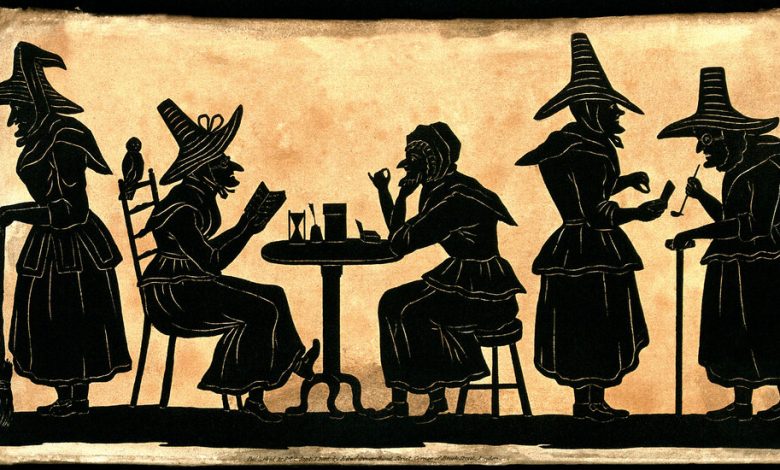Two Books Explore the Lives of Witches

ASHES AND STONES: A Journey Through Scotland in Search of Women Hunted as Witches, by Allyson Shaw
THE WITCHING YEAR: A Memoir of Earnest Fumbling Through Modern Witchcraft, by Diana Helmuth
From “MacBeth’s” weird sisters to Snow White’s evil stepmother, witches have long enchanted our collective imagination. They are dangerously seductive; they are old hags; deceitful; estranged from society; unmarried and childless. Almost always, they are women.
In “Ashes and Stones,” an incantational group biography infused with personal narrative, Allyson Shaw excavates lives exploited by literature and pop culture, calling witch hunts what they were: femicide. Tens of thousands of women across Europe were murdered between the 16th and 18th centuries in state-sanctioned and extrajudicial executions. At least 2,000 took place in Scotland, largely driven by the protestant King James VI and I, whose translation of the Bible commands “Thou shalt not suffer a witch to live.”
Shaw draws James I as a sadist driven by a delusion that “witches” on trial in Copenhagen were conspiring with their Scottish sisters on behalf of the devil’s minions to subvert his power. Under his authority, landowners and church leaders policed their women. An elder’s age spots became the devil’s mark. A man’s financial troubles became grounds for accusing his servant of wielding witchcraft against him, as in the case of Gelie Duncan. She was an easy target: a “healer” who enjoyed moonlit walks. Duncan was arrested, interrogated and tortured into confessing her role as what Shaw terms “the first foot soldier in Satan’s mighty army.” A witness to her formal trial recorded that King James “took great delight” in watching. After her thumbs were broken, the king ordered her to perform on a harp the music she made for the devil.
Witchcraft confessions, Shaw’s principal sources, were recorded by accusers, interrogators and judges. Frustrated by the paucity of humanizing details in these one-sided accounts, Shaw embarks on a pilgrimage across Scotland to memorials where the accused lived, died and in some cases survived, crippled and ostracized. Originally from California, she moves into a cottage on the northeast coast of Scotland, her ancestral homeland. She is a self-described “hedge witch,” a “liminal thinker, someone open to the edges where other ways of knowing seep in.”
Shaw passes over centuries-old footsteps like fingers on Braille; the lilt of her voice on the page is lyrical magic. In Spott, a stone memorializing Marion Lillie sits “unassumingly” on a margin of flourishing land alongside a highway. “At Marion’s stone, this green verge also shelters our memory of the accused.” At Orkney, Shaw honors an executed unmarried mother, a teenager named Elspeth.
“Ashes and Stones” is characterized by a reverence for land that absorbed the ashes of injustice. Shaw pays homage to the hunted while elevating modern self-identified witches as feminist archetypes.
In “The Witching Year,” Diana Helmuth approaches witchcraft with the deference of a teenager playing on an Ouija board at a slumber party. Bored during Covid isolation, she decides to immerse herself in contemporary witchcraft for a year so that she can write a book about it. Helmuth unabashedly announces that she will rely on A.J. Jacobs’s best seller “The Year of Living Biblically” as her template. It’s an odd disclosure from someone longing for originality “in a world of increasing homogeneity,” but Helmuth adapts her subject to the prototype — the droll tone, the partner as foil, the staging of source material for a photo op. Helmuth posts hers on Instagram with the caption “New Project, What Could Go Wrong?”
She commences her journey by Googling “best books for beginner witches” because “the internet is where I have found every other piece of information in my life.” She consults TikTok and Twitter. She drops a dozen witchcraft tomes into her online shopping cart and starts the clock, inviting us on a journey that will span Zoom fatigue, vaccination cards, Delta, Omicron and the end of mask mandates.
A modern American witch is a channeler of energies — “basically a Wi-Fi router” — and whatever else she wants herself to be, Helmuth writes, dispelling stereotypes about Goth rebels, and more, along the way. The religion offers followers a kind of D.I.Y. self-help program concocted from a buffet of often culturally appropriated practices (the author addresses them sensitively throughout).
She begins to fill her plate with crystals and pentacles, tarot cards, spells, astrology (which she was once “really, really into”), and the centuries-old technique of guided meditation among other tools adopted by mainstream psychology. She attends “witch camp” and makes pilgrimages to Salem and Stonehenge.
On Day 170, she tunes into a Spotify playlist of synthesizer music in D minor and prepares a makeshift altar crafted from cardboard topped with a plastic cow. The goal is to commune with the goddess Isis. Hopeful but skeptical, Helmuth exploits the eye-rolling potential here and elsewhere with sardonic humor. To her surprise, the exercise yields results. A self-induced trance has led to radical self-acceptance. On Day 175, she is empowered to post her weight on Instagram.
At a coven, she participates in a ritual purging of grief around a person or event. Helmuth chooses to focus on her father, an addict who abandoned her when she was 4 and died suddenly when she was a teenager, just as they’d begun rekindling their relationship. What follows — heart-rending reflection woven into a gripping scene — demonstrates Helmuth’s underutilized capacity for crafting narrative with momentum.
In her epilogue, Helmuth joins Shaw in making a strong feminist case for reclaiming the word “witch” from stereotypes, associating it instead with ecological acumen and prevailing over patriarchy. Mainstream culture is beginning to cast witches as emboldened female agents for good. In the musical “Wicked,” the protagonist witch, Elphaba, transforms from a timid outcast to a potent animal activist celebrated for embracing her sensuality. But Elphaba’s skin remains green-hued — a witch cliché born centuries ago on the discolored faces of battered women burned at the stake. Trotting out little girls in pointy black hats on Halloween suddenly seems not so cute.
How did the brutal beatings of innocent women become elements of entertainment? And what horrors in our own relatively recent history will be swept under the rug as a product of “unenlightened times?” The answers, of course, flow from who tells the stories.
ASHES AND STONES: A Journey Through Scotland in Search of Women Hunted as Witches | By Allyson Shaw | 292 pp. | Pegasus | $28.95
THE WITCHING YEAR: A Memoir of Earnest Fumbling Through Modern Witchcraft | By Diana Helmuth | 335 pp. | Simon Element | $27.99




